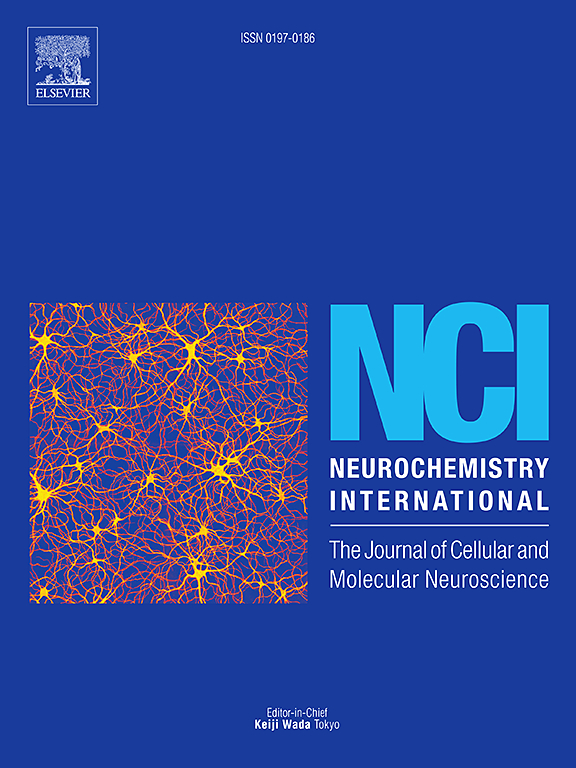Antinociceptive and anti-inflammatory effects of dihydroaustrasulfone alcohol in alleviating peripheral neuropathy via Nrf2/HO-1 pathway in rats
IF 4
3区 医学
Q2 BIOCHEMISTRY & MOLECULAR BIOLOGY
引用次数: 0
Abstract
Peripheral neuropathic pain is closely associated with neuroinflammation and oxidative stress accumulation in the spinal cord dorsal horn (SCDH), but effective treatments remain limited. Dihydroaustrasulfone alcohol (WA25), a synthetic precursor of austrasulfone obtained from a Formosan soft coral, has anti-inflammatory and antioxidant properties. However, its potential therapeutic effect on neuropathic pain is yet to be established. This study aimed to elucidate the cellular mechanisms responsible for therapeutic potential of WA25 in rats with neuropathic pain. Neuropathic pain was induced in rats via chronic constriction injury (CCI), and WA25 was intrathecally administered in these rats. To evaluate the analgesic effects of WA25 and the underlying cellular mechanisms, nociceptive behavior assessment and immunofluorescence staining, respectively, were employed. WA25 significantly alleviated CCI-induced nociceptive behavior, neuroinflammation, and oxidative stress accumulation. Further, WA25 enhanced the expression of astrocytic nuclear factor erythroid 2-related factor 2 (Nrf2) and heme oxygenase-1 (HO-1) in the ipsilateral SCDH, suggesting its role in mitigating inflammation and oxidative stress. The co-administration of the HO-1 inhibitor ZnPP abolished the analgesic, anti-inflammatory, and antioxidant effects of WA25. The findings of the study suggest that WA25 effectively attenuates nociceptive sensitization, neuroinflammation, and oxidative stress accumulation in rats via the activation of the Nrf2/HO-1 signaling pathway, highlighting its potential as a therapeutic agent for neuropathic pain management.

二氢奥斯柳酮醇通过Nrf2/HO-1通路减轻大鼠周围神经病变的抗伤性和抗炎作用
周围神经性疼痛与脊髓背角(SCDH)的神经炎症和氧化应激积累密切相关,但有效的治疗方法仍然有限。摘要二氢奥氏磺胺醇(WA25)是从台湾软珊瑚中提取的奥氏磺胺的合成前体,具有抗炎和抗氧化的特性。然而,其对神经性疼痛的潜在治疗作用尚未确定。本研究旨在阐明WA25对神经性疼痛大鼠治疗潜力的细胞机制。通过慢性收缩损伤(CCI)诱导大鼠神经性疼痛,并在鞘内给予WA25。为了评估WA25的镇痛作用及其潜在的细胞机制,分别采用伤害性行为评估和免疫荧光染色。WA25显著减轻cci诱导的伤害性行为、神经炎症和氧化应激积累。此外,WA25增强了同侧SCDH中星形细胞核因子-红细胞2相关因子2 (Nrf2)和血红素加氧酶-1 (HO-1)的表达,提示其在减轻炎症和氧化应激中的作用。同时给药HO-1抑制剂ZnPP可消除WA25的镇痛、抗炎和抗氧化作用。研究结果表明,WA25通过激活Nrf2/HO-1信号通路,有效减轻大鼠的伤害性致敏、神经炎症和氧化应激积累,突出了其作为神经性疼痛治疗药物的潜力。
本文章由计算机程序翻译,如有差异,请以英文原文为准。
求助全文
约1分钟内获得全文
求助全文
来源期刊

Neurochemistry international
医学-神经科学
CiteScore
8.40
自引率
2.40%
发文量
128
审稿时长
37 days
期刊介绍:
Neurochemistry International is devoted to the rapid publication of outstanding original articles and timely reviews in neurochemistry. Manuscripts on a broad range of topics will be considered, including molecular and cellular neurochemistry, neuropharmacology and genetic aspects of CNS function, neuroimmunology, metabolism as well as the neurochemistry of neurological and psychiatric disorders of the CNS.
 求助内容:
求助内容: 应助结果提醒方式:
应助结果提醒方式:


